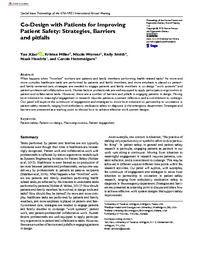
ATTENTION: The works hosted here are being migrated to a new repository that will consolidate resources, improve discoverability, and better show UTA's research impact on the global community. We will update authors as the migration progresses. Please see MavMatrix for more information.
Show simple item record
| dc.contributor.author | Xiao, Yan | |
| dc.contributor.author | Miller, Kristen | |
| dc.contributor.author | Werner, Nicole | |
| dc.contributor.author | Smith, Kelly | |
| dc.contributor.author | Hendrix, Noah | |
| dc.contributor.author | Hemmelgaru, Carole | |
| dc.date.accessioned | 2023-11-02T19:29:48Z | |
| dc.date.available | 2023-11-02T19:29:48Z | |
| dc.date.issued | 2023 | |
| dc.identifier.uri | http://hdl.handle.net/10106/31827 | |
| dc.description.abstract | What happens when “frontline” workers are patients and family members performing health-related tasks? As more and more complex healthcare tasks are performed by patients and family members, and more emphasis is placed on patient- and family-centered care, strategies are needed to engage patients and family members in co-design “work systems” and patient-professional collaborative work. Human factors professionals are well-equipped to apply participatory ergonomics to patient and collaborative tasks. However, there are a number of barriers and pitfalls in engaging patients in design. Moving from tokenism to meaningful engagement in research requires patience, constant reflection, and a commitment to codesign. Our panel will explore the continuum of engagement and strategies to move from tokenism to partnership to cocreation in patient safety research, ranging from ambulatory medication safety to diagnosis in the emergency department. Strategies and barriers are presented as a starting point to discuss how to achieve effective work system designs. | en_US |
| dc.language.iso | en_US | en_US |
| dc.relation.ispartofseries | Proceedings of the Human Factors and Ergonomics Society Annual Meeting; | |
| dc.subject | patient safety | en_US |
| dc.subject | patient co-design | en_US |
| dc.subject | macroergonomics | en_US |
| dc.subject | patient engagement | en_US |
| dc.title | Co-Design with Patients for Improving Patient Safety: Strategies, Barriers and pitfalls | en_US |
| dc.type | Article | en_US |
| dc.rights.license | This article is distributed under the terms of the Creative Commons Attribution-NonCommercial 4.0 License (https://creativecommons.org/licenses/by-nc/4.0/) which permits non-commercial use, reproduction and distribution of the work without further permission provided the original work is attributed as specified on the SAGE and Open Access page (https://us.sagepub.com/en-us/nam/open-access-at-sage). | |
| dc.identifier.doi | https://doi.org/10.1177/21695067231192416 | |
Files in this item
- Name:
- xiao-et-al-2023-co-design-with ...
- Size:
- 145.5Kb
- Format:
- PDF
- Description:
- main article
This item appears in the following Collection(s)
Show simple item record


